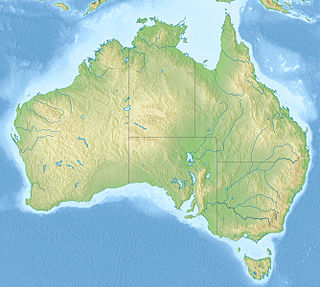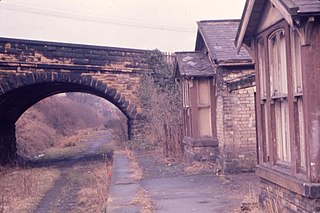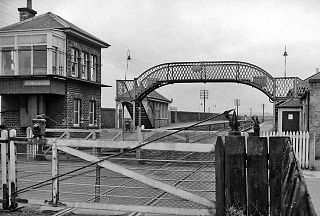
Bonnyrigg is a town in Midlothian, Scotland, eight miles southeast of Edinburgh city centre. The town had a population of 14,663 in the 2001 census which rose to 15,677 in the 2011 census, both figures based on the 2010 definition of the locality which, as well as Bonnyrigg and the adjacent settlement of Lasswade, includes Polton village, Poltonhall housing estate and modern development at Hopefield. The estimated population for 2018 is 18,120, the highest of any town in Midlothian. Along with Lasswade, Bonnyrigg is a twin town with Saint-Cyr-l'École, France.
The Esk Valley Line is a railway line located in the north of England, covering a total distance of around 30 miles (48 km), running from Middlesbrough to Whitby. The line follows the course of the River Esk for much of its eastern half.

Egton is a railway station on the Esk Valley Line, which runs between Whitby and Middlesbrough. The station serves the villages of Egton and Egton Bridge in North Yorkshire. It is owned by Network Rail and managed by Northern Trains.
The Crieff and Methven Junction Railway was a Scottish railway, opened in 1866, connecting Crieff with a branch line that ran from Methven to Perth.

The Picton–Battersby line was a section of railway line running from Picton, North Yorkshire, England, on what is now the Northallerton–Eaglescliffe line, to Battersby on what is now the Esk Valley line.

Eskbank railway station is a station serving the Eskbank area of the town of Dalkeith, Midlothian, Scotland. It reopened on the Borders Railway between Edinburgh and Tweedbank, just beyond Galashiels. There is a half-hourly service to Tweedbank. It is approximately a mile from Dalkeith town centre. Car parking space is available for 248 cars and also cycle storage space.
The Glasgow to Aberfoyle Line was a railway line in Scotland, built in stages, leaving the Edinburgh and Glasgow Railway near Lenzie. Tourist traffic was a dominant part of the motivation for building the line, and road tours to the Trossachs from Aberfoyle formed a significant part of the traffic.

The Brisbane Valley railway line was a railway connection in Queensland, Australia connecting Ipswich, west of Brisbane, to the upper Brisbane River valley. Progressively opened between 1884 and 1913 the railway provided a vital transport link between Ipswich and Yarraman and forged development and prosperity along its path. The line acquired its serpentine reputation because it did not take a straight course when faced with a hill or gully.
The Edinburgh, Loanhead and Roslin Railway was a railway line south of Edinburgh, Scotland, built primarily to serve mineral workings, although passenger trains were operated. It is also known as the Glencorse Branch of the North British Railway. It opened from a junction at Millerhill on the Waverley Route, to Roslin in 1874 and was extended to a location near Penicuik to serve Glencorse Barracks and a colliery in 1877 and to Penicuik Gas Works in 1878.
The Peebles Railway was a railway company that built a line connecting the town of Peebles in Peeblesshire, Scotland, with Edinburgh. It opened on 4 July 1855, and it worked its own trains.
The Esk Valley Railway was a short branch line built to serve industry in the valley of the River North Esk, south of Edinburgh in Scotland. The terminus was Polton. The line opened on 15 April 1867
The Penicuik Railway was a railway line in Midlothian, Scotland, serving paper mills located on the River North Esk. It opened in 1872 and a substantial residential passenger traffic built up. The line was 4 1/2 miles long.

Rowlands Gill railway station served the village of Rowlands Gill, Tyne and Wear, England from 1867 to 1963 on the Derwent Valley Railway.
Knitsley railway station served the hamlet of Knitsley, County Durham, England from 1862 to 1939 on the Lanchester Valley Railway.

Lanchester railway station served the village of Lanchester, County Durham, England from 1862 to 1965 on the Lanchester Valley Line.
Witton Gilbert railway station served the village of Witton Gilbert, County Durham, England from 1862 to 1963 on the Lanchester Valley Line.

Bonnyrigg railway station was a railway station that served the town of Bonnyrigg, Midlothian, Scotland from 1855 to 1965 on the Peebles Railway.
Lasswade railway station served the village of Lasswade, Midlothian, Scotland from 1868 to 1964 on the Esk Valley Railway.
Polton railway station served the village of Polton, Midlothian, Scotland from 1867 to 1964 on the Esk Valley Railway.

Esk Bridge railway station served the settlement of Esk Bridge, Midlothian, Scotland from 1874 to 1930 on the Penicuik Railway.









